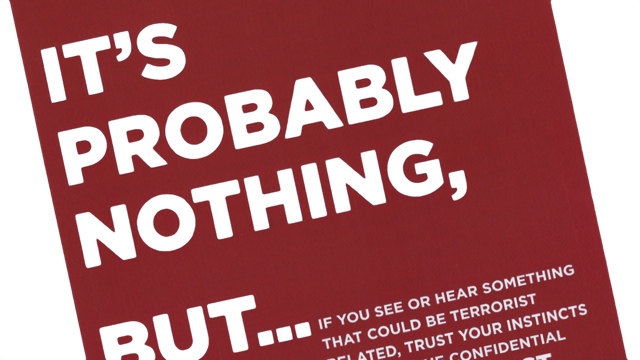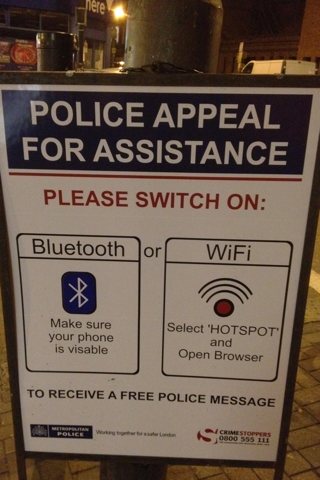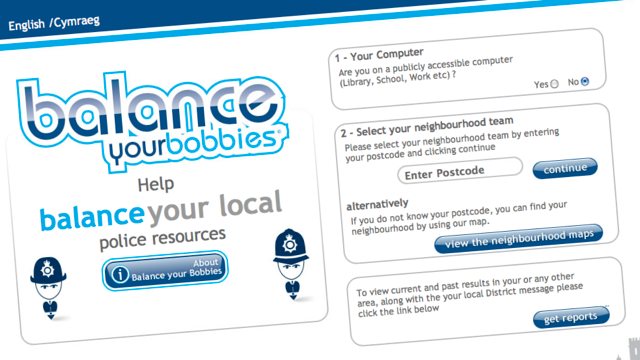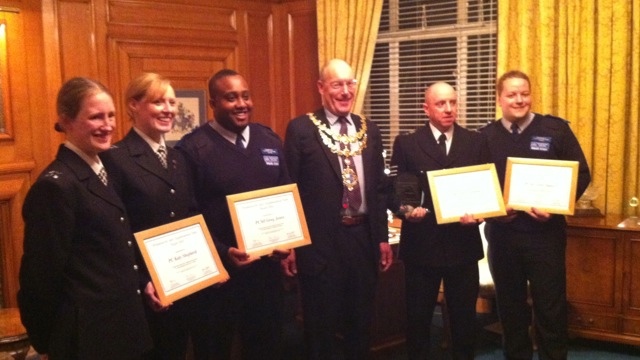
If you want to let them know about your views on local policing or find out what the priority crimes in the area (as well as get crime prevention advice from them) they will be in McDonald’s from noon until 4.00pm.

If you want to let them know about your views on local policing or find out what the priority crimes in the area (as well as get crime prevention advice from them) they will be in McDonald’s from noon until 4.00pm.

Thanks to the leaflet the Met popped through my door the other day I know exactly what to look out for to prevent terrorism.
I’m reassured that I’m playing my part, looking out for people who have “bought or hired a vehicle in suspicious circumstances.” or who hold “passports or other documents in different names for no obvious reason” (my emphasis), you know, the sort of things you wouldn’t have thought in any way odd before the leaflet (or this blog post) told you.

While not quite as bad as the 2009 campaign which wanted you to shop your neighbour if they were doing too much washing up it still seems based on the idea that you should automatically fear something that’s outside your normal range of experience.
My problem with these annual campaigns is two-fold.
First, they are useless. “It’s probably nothing, but…” is more an invitation to report anything, than it is practical advice to a community. It is so vague and generic as to be useless. Should I fear my neighbour, because he has fertiliser and a large vehicle? Or should I see if his gardening business could give my back-yard a quick once over? If the Met were serious, they’d be looking at far more practical advice tailored to the community.
Second, the biggest impact of this leaflet is to spread fear and uncertainty. We can ‘defeat terrorism’, we are told, but it doesn’t really put the problem into a context. Terrorist attacks are gruesome, high-profile and incredibly emotive, but looked at objectively represent a miniscule fraction of human activity. As Dan Gardner pointed out over a year ago, terrorism in Europe has been declining, and most terrorism aims to further specific nationalist issues (mainly Basque separatism).
What is particularly telling is that the decline is not just in terrorist attacks, but in failed and foiled plots as well. In other words, there aren’t just fewer terrorist incidents in Europe, there are fewer attempted terrorist incidents too.
Of course, you might argue that by creating a climate of fear and suspicion terrorists are unable to operate. I’m not sure I want to live in a society where the majority live in constant fear and suspicion of a small (but exaggerated) minority who would kill them.
According to the Global Terrorist Database there were just four terrorism-related fatalities in Western Europe in 2010, three in Greece and one in Sweden. When you compare it to around 700 smoking-related deaths per year in Wandsworth alone you have to wonder why we are so keen to create fear of terrorism.
 This sign, one of many that have appeared around Clapham Junction after the recent murder there, caught my attention. It struck me as a surprisingly innovative approach to witness appeals, especially as the police (with good reason) place a lot of faith in traditional, tried and tested, approaches.
This sign, one of many that have appeared around Clapham Junction after the recent murder there, caught my attention. It struck me as a surprisingly innovative approach to witness appeals, especially as the police (with good reason) place a lot of faith in traditional, tried and tested, approaches.
A few thoughts, positive and negative, occurred to me.
Is it a use of technology for the sake of it? I don’t know, but I’d be fascinated to see any long-term study of the results of different methods of witness appeal. And of course, the value of evidence may well outweigh the disadvantages of any particular method and that’s a judgement call the police have to make.
This particular appeal relates to the murder of Richard Ward, for which two arrests have been made, but if you have any information you can call the incident room on 020 8721 4961 or Crimestoppers anonymously on 0800 555 111.

North Wales are running a ‘Balance Your Bobbies’ website for well-over a year, so I’m disappointed I only found out about it last week, because it looks like a really interesting site.
It’s similar to the ‘You Choose’ budget simulator that several councils are using to involve residents in budget decisions, but instead asks people to balance police resources between various neighbourhood priorities.
It does lack some of the finesse of the You Choose model, it doesn’t, for example, attempt to suggest any of the consequences of decisions: for example dedicating a team to ASB might help remove much of it and give highly visible results, but dedicating a team to burglary wouldn’t, most people aren’t aware of burglaries even nearby and only when someone is caught in the act do we know that a specific burglary has been prevented.
However, it does start to introduce residents to the concept of prioritisation for the police – every day the police have to make operational decisions on what they are doing. If you look at trends locally, you can detect the impact some operations have, which aren’t always positive: if you focus on reducing one crime it may mean that other crimes start to creep up. At the neighbourhood level, when you ask your police team to tackle one problem, it means there are lots and lots of things they aren’t tackling.
In London, there is a particular issue since the model of neighbourhood policing is going to change. Instead of the model of each ward having about the same size of team (one sergeant, two constables, three PCSOs) they are being rebalanced according to need. In effect, areas with relatively few problems will lose officers to those areas with more problems. Frankly, the standard size model, a consequence of the rapid introduction of Safer Neighbourhood Teams (SNTs) in London, was never sustainable.
I have been criticised in the past for saying it – but stick by my belief – that it’s impossible to justify dedicating the same level of policing to an area with the top priority of cycling on pavements as to an area concerned with anti-social behaviour problems associated with drink and drugs.
We’re going through the end of our strategic assessment process, and one of the strongest criticisms of it has not been the priorities we’ve suggested, but that we didn’t involve residents at an earlier stage. And we didn’t. That’s something we need to improve.
Even if it’s not perfect, Balance Your Bobbies starts a process of getting people thinking about the issues they face and how to tackle them. Taken a little further, it could start educating both those involved in policing about what the public wants, but also educating the public about the broader strategic priorities and how their decisions – with their SNTs – can feed into them.
It would be fascinating to see how something similar would work in Wandsworth. What would you want your SNT concentrating on? But, perhaps more importantly, what wouldn’t you mind them ignoring?

AMENDMENT: I was trying to be informative, but I was misinformed (or possibly just incompetent)! The meeting is tonight at 7pm, but at the Devas Club on Stormont Road, although I don’t have a nice image of that.
The Shaftesbury Safer Neighbourhood Team hold their regular public meeting this evening.
Starting at 7pm in Battersea Arts Centre it’s a chance to talk to your local police team and find out what they are doing to make Shaftesbury ward safer. You can also find out what crime is like in the area from the national police crime maps.
Unfortunately I won’t be there (I’ll be somewhere between Wales and London, hopefully closer to the latter) but my ward colleague Jonathan Cook does plan to attend, so can help with council related matters.

Congratulations to Northcote Safer Neighbourhood Team who picked up their SNT of the Year award from the Mayor of Wandsworth last night.
While there was some stiff competition, their nomination was impressive for showing a wide range of engagement with not just local residents but also local businesses and schools. I know how big a role they played in installing the well-liked AlertBox system along Northcote Road so it was good to see this recognised with lots of nominations from those businesses.
Congratulations to them all.

After all the fuss about my old crime maps and the crime briefing the council would send out to Neighbourhood Watch coordinators the government are the ones to ride in and save the day with their new crime mapping system.
You can read about the sad history of my crime maps in a post I published at the time, but the short story is that after 18 months of publishing them a complaint from Harrow Council brought them, and the council briefings I used to create them, to an end.
This was annoying, not least because we knew that pretty much every other council continued (and continues) to produce the same sort of crime briefing to inform their Neighbourhood Watch coordinators. But having been identified, we had to stop. This was, and continues to be, an incredibly sore point for many people who valued the regular briefing.
But now the government has come good on its commitment to providing ‘street level’ information on crime. I first heard that publication was imminent a few weeks ago, and was surprised when I was told how they would work, mainly because the Information Commissioner has been so insistent that this sort of mapping isn’t acceptable.
The new mapping site follows almost the same methodology as my maps did, using the central point for a road to spot map crime. But it has a lot more information than mine did, mapping anti-social behaviour, robbery, burglary, vehicle crime, violent crime and a generic category for all other crime. I’m convinced these work well in informing the public. In most cases, I suspect people will be surprised at how low crime is: when I was producing my maps people just assumed crime rates were much higher. But they are a valuable took which enable people to hold the relevant authorities to account.
I’d love to know what you think of them, but most of all I would love to know what the Information Commissioner thinks about it!
We’re currently going through our annual process of reassessing our community safety priorities, and as part of that consulting on what they should be and any issues you might have. Rather than re-write, the council’s text, and details of how you can take part, are below:
HELP MAKE WANDSWORTH A SAFER PLACE
Each year the Community Safety Partnership (the Council, Police, Fire Service, Probation and Primary Care Trust) reviews the priorities for reducing crime and disorder within Wandsworth. Following our analysis of crime and disorder within the borough, we now need to consult widely to confirm our understanding of what must be done. We therefore seek your views by completing a short questionnaire, the results of which will be used to determine our priorities for 2011/12.
This link will take you to the questionnaire which you can fill in online. You are invited to circulate the link as widely as possible to any individuals or groups within the borough that you are associated with who may be interested.
If you prefer, a printed copy of the survey can be provided; please telephone 0208 871 6603, stating your address and the number of copies required. When completed, the printed copy should be returned to:-
Director of Technical Services,
Community Safety Division,
Wandsworth Borough Council,
The Town Hall,
Wandsworth High Street,
London SW18 4BR.
The questionnaire can also be provided in large print if required.
One of my concerns about the rush towards spending transparency for councils (Wandsworth publishes spending by vendor by month) are the unintended consequences. The We Love Local Government blog raises the question of whether it is actually more likely to lead to bad, rather than good, spending decisions.
The rationale is fairly simple; because there is a fear of published spending being criticised councils go for options that may be cheaper, but worse value. The example cited is of using a cheaper hotel, but then losing the saving in transport costs because of the hotel’s location. While I’ll use this example in this post but there will be many many similar situations across the country. I know that £500 has become a psychology spending limit for many, not because of any explicit instruction, but because of the knowledge that spending will be published.The result risks false economies. £510 on hotels hits the limit and is published. But £490 on hotels and £100 on taxis does not.
I think there’s a very simple way to tackle this and retain transparency: lower the publishing limit to zero. Then there aren’t the unintended consequences of people trying to spend below arbitrary limits on single items and all spending may need justifying to the public. This moves the whole thought process from “how can I keep all the individual spending below the publishing radar” to “how can I justify the total cost.”
And while it will require a culture change (for a time the Taxpayers Alliance will have a field day) when that happens I’m optimistic enough to think there will be scope for much more intelligent debate about the role and quality of local government. Instead of knee-jerk reactions to council officials living a ‘high-life’ in a hotels would it be too much for the reaction not to about whether the trip brought as much value to the borough as it cost?
It is only marginally related, but Greater Manchester Police’s decision to tweet all their calls is an example of this. There were, predictably, outbursts that such activity was a waste of money and the police should have been on the streets (no prizes for guessing it was the Taxpayer’s Alliance seeing their blood pressure rise again). But at the end there were huge numbers of people aware of what a police force actually finds itself doing, and I suspect a lot of people in Manchester suddenly much better informed about the true level of crime and disorder in their city. It’s a fair bet that a reduction in unnecessary calls will pay for the ‘experiment’ many times over. But most
I can’t help thinking that while the initial transition may be hard – resisted by some and lead to criticism from others – the more transparency and openness there is the better for everyone.
Lambeth police, never worried about doing things differently, seem to be bucking the usual pattern that policing follows. An article in the Streatham Guardian details their plans to move more police into neighbourhood policing.
Traditionally the police have had a cyclical approach to policing alternating between a response and a neighbourhood focus. To give a simplistic explanation:
If you start with ‘response’ policing, then dedicated police officers concentrate on responding to calls – so when you see the police they are probably on their way to, from or at a 999 call. However, the public begin to complain. They never see the police on the beat. They have no way of communicating with them unless in emergencies. They want Dixon of Dock Green policing where they knew their local bobby and their local bobby knew them. Public confidence falls.
So the police adopt ‘neighbourhood’ policing. They have officers dedicated to specific beats. They are tasked not just to uphold law and order, but to engage with their communities and respond to their concerns. But that means resource that could be dedicated to response is re-directed. Average response times will fall because there are a fewer dedicated response officers. For calls categorised as a low-priority, where, for example there’s no human harm and little prospect of catching anyone it means the victim just has to wait at the back of the queue until someone can see them. The public begin to complain. They can’t get a prompt response. They shouldn’t have to wait hours for the police to see them and take evidence. Public confidence falls.
So the police…
You get the idea. This cycle has repeated a few times, most recently with Safer Neighbourhood Teams (SNTs) – a model started in London and now replicated across the country – but, frankly, probably overdue for a reversion back to response policing.
So I am amazed that a further expansion of neighbourhood policing is being considered in Lambeth.
A radical overhaul of policing in Lambeth is planned, in what the borough’s top cop has billed as “probably the most significant change to the service in years”.
Scores of officers are set to be transferred into neighbourhood policing, as borough commander Chief Superintendent Nick Ephgrave oversees a pilot scheme that could form the model for policing across London.
Two thirds of officers who make up the borough’s emergency response teams are instead set to join “neighbourhood teams” to bolster community policing.
This runs counter to what I think seems to be the prevailing wisdom with the police everywhere: given the huge financial constraints they need to focus on their ‘core’ business, and that means moving resource from neighbourhood policing to response teams.
To a degree I have sympathy with that view. At the core of the SNT policing model is that every team is generally the same size (one sergeant, two constables, three support officers), and that each local government ward has a team. But, of course, not every area has the same problems, and those problems don’t often respect ward boundaries.
The public might be satisfied by it, but is it really a valuable use of police officers to have one team of six dedicated to dealing with cycling on the pavement while another team of six has to deal with drug dealing and anti-social behaviour from youths associated with it?
But I think the crucial element we mustn’t lose is the public accountability and interface. It might not be working perfectly, but it’s vital that residents have a way of influencing policing in their area. That, in part, is behind my passion for public and open data – so they can play an informed role and set intelligent priorities. One thing I that I think is proven by the Redbridge YouChoose consultation is that people, given the information, are capable of understanding and making difficult decisions, even if they do not necessarily like them – and that might mean tolerating pavement cyclists.
However, that’s where the Lambeth proposal seems to fall down:
If the pilot is approved by the Metropolitan Police it will cover policing responsibilities set by the inspectors that lead them, as opposed to resident-led SNT panels.
It might just be that these are locally based response teams. The crucial factor will be what priorities the inspectors set. If those priorities are to back up the SNTs, but to concentrate on the major problems (and not the miscreant cyclists) it could be an incredibly exciting experiment, both for residents and policing. With police resources flexibily allocated, allowing them to respond when necessary but using free time to address the most pressing resident concerns it might just provide the best of both worlds and end the response/neighbourhood cycle.
It will be interesting to see how it all works in practice.